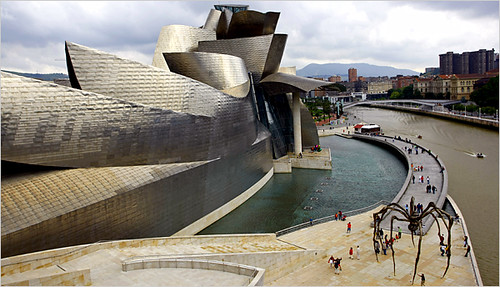Brilliant photo/essay on the decline of center cities + the "Bilbao Effect"

In keeping with the theme that historic preservation is a strategy or program for community improvement that transcends the desires of individual architects or property owners to build a single building, I came across an essay by the photographer-author Jeff Brouws, which is reprinted at the B-Mode blog.
The photographs of decay and the way he organizes and types these photographs are brilliant.
From the introduction:
Feeling kinship with the New Topographics Movement from the 1970s that documented the impact of the constructed suburban world on the natural one, I wanted to invert that premise — looking at the urban core instead of the periphery — and ask how suburbanization after World War II affected city centers. What were the consequences as we went from an urban, city-dwelling lifestyle — based on mass transportation, high density living, and production — to a suburban, car-dependent, low-density lifestyle based on consumption?
It's trying to reverse or prevent decay that motivates the historic preservation movement, not a desire to promote nostalgia.
A one-off building or project very very very very very very very very very very rarely is enough to reverse longstanding patterns of neighborhood, commercial district, or community disinvestment.
Even if it's a building designed by a starchitect.
It's a building, not a program/plan/strategy.
Even the "Bilbao Effect" is more than the museum building by Frank Gehry.
And many other cities trying for a "Bilbao Effect" of their own haven't succeeded.
Even Frank Gehry agrees. See "Frank Gehry: the Bilbao Effect is bulls**t" from the Times of London. From the article:
But this morning, speaking in front of the temporary summer pavilion he has designed for the Serpentine Gallery in Hyde Park, Gehry, 79, said that the so-called “Bilbao Effect” had been misunderstood.
“It’s a bunch of bullshit,” he said. “You do a building, you solve the problems, people are happy and that’s nice.”
However, a really successful building, like the Guggenheim, cannot simply be churned out to order. “It is kind of a miracle, you don’t quite know how it happens”.
“In the case of Bilbao, they asked for Sydney Opera House when we started but they had a comprehensive plan for the community. Foster did the subway system, Jim Stirling was doing a train station that never happened, Calatrava did the airport and everybody did a vineyard.
“So there was sort of an intent to change the community and it worked.”
Hyping the power of one building to revive an area is also a distraction from the real business of putting up good buildings, Gehry said. “I don’t think you start out to make a marquee development. They talk about “spectacle architecture” and I think people jump on these kind of things but from my point of view I don’t start out to do that.
Also see "Welcome to the Land of ‘Wow-Factor’ Museums" and "Bilbao, 10 Years Later" from the New York Times.Labels: car culture and automobility, historic preservation, urban revitalization, urban vs. suburban



5 Comments:
This comment has been removed by the author.
For me personally, studybay reviews ranks first in the top of similar companies, because everything is open here. You can control the whole process by adding some corrections if you agree with the writer in advance.
This comment has been removed by the author.
Recently started using the site https://yourmailorderbride.com/british-brides/ it has a lot of decent and attractive girls, which is very pleasing. Of course, I have not found a bride yet, but I think everything will be fine.
I read this article. This is very informative and helpful for us. The vast majority of the museum's visitors come from outside the Basque region, and more than half are from other countries. Keep sharing more information about this article. Now it's time to get Best Roofing Services in Wayne NJ for more information.
Post a Comment
<< Home